Would you like to learn some SEO growth hacks to help boost your rankings and traffic?
Search engine optimization (SEO) has become very competitive, and you need to know the right strategies to help you achieve your goals.
In this article, we’ll show you some effective SEO growth hacks you can use to outrank your competitors and drive targeted traffic to your site.
What are SEO Growth Hacks?
Growth hacking refers to strategies and techniques focusing on rapid and efficient growth. This growth is achieved through creative means that don’t need huge budgets.
SEO growth hacks, therefore, refer to SEO strategies designed to fast-track your rankings, boost your traffic, and increase your organic conversion rates.
How Do You Grow in SEO?
Achieving SEO success involves a strategic combination of techniques to enhance your online visibility, increase website traffic, and, ultimately, drive conversions. It’s not just about knowing the basics; it’s about mastering the art of SEO growth.
This guide will delve into 13+ SEO growth hacks designed to propel your website to new heights.
13+ SEO Growth Hacks to Help You Outrank Your Competitors
1. Use the Right WordPress SEO Tool
One of the first SEO growth hacks you should implement is to ensure you’re using the right SEO tool. And for WordPress users, there’s no better tool than All In One SEO (AIOSEO).

AIOSEO is the best SEO monitoring tool for WordPress. It’s a powerful SEO plugin boasting over 3 million active installs. Millions of savvy website owners and marketers trust the plugin to help them dominate SERPs and drive relevant site traffic. This is because the plugin has many powerful SEO features and modules to help you optimize your website for search engines and users. Examples include:
- Cornerstone Content: Easily build topic clusters and enhance your topical authority and semantic SEO strategy.
- SEO Revisions: Track any changes you make to your site and see their impact on your SEO. Plus, you get to see on a timeline how Google updates affect your site.
- Advanced Robots.txt Generator: Easily generate and customize your robots.txt file for better crawling and indexing.
- TruSEO Highlighter: Makes it easy to spot on-page SEO issues and gives recommendations for fixing them.
- Next-gen Schema generator: This no-code schema generator enables users to generate and output any schema markup on your site.
- Redirection Manager: Helps you manage redirects and eliminate 404 errors, making it easier for search engines to crawl and index your site.
- Link Assistant: Powerful internal linking tool that automates building links between pages on your site. It also gives you an audit of outbound links.
- SEO Preview: This gives you an overview of your search and social snippets and general SEO so you can improve your optimization.
- IndexNow: For fast indexing on search engines that support the IndexNow protocol (like Bing and Yandex).
- Sitemap generator: Automatically generate different types of sitemaps to notify all search engines of any updates on your site.
- And more
AIOSEO also has many other features to help you boost your local SEO, on-page SEO, and technical SEO. And, if you’re a WooCommerce user, AIOSEO has a tailor-made WooCommerce SEO module to help you rank your online store higher in search rankings. Plus, we have page builder integrations with many popular WordPress page builders to help you optimize your pages on the fly.
For step-by-step instructions on how to install AIOSEO, check our detailed installation guide.
2. Conduct Proper Keyword Research
Proper keyword research is one of the most important SEO growth hacks to help boost your online visibility. It involves identifying the words and phrases your target audience uses to find your blog content, products, or services. There are many tools you can use for this, including Ahrefs, Semrush, and more.
If you’re in a competitive niche, you’ll have better success at targeting long-tail keywords as they have lower keyword difficulty.
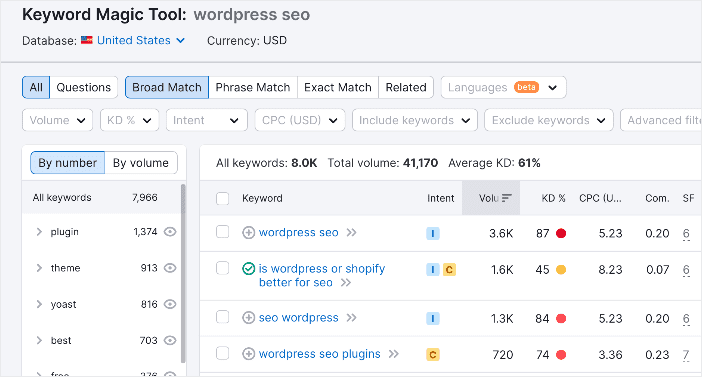

Check out our list of recommended keyword research tools here.
Besides finding the right keywords, you should know how to use them strategically. A few ways include adding your focus keyword to your:
- Headline
- SEO title
- Meta description
- Introduction and conclusion
- Headers (H1, H2, H3, etc.)
- URL
However, you should avoid keyword stuffing, which is the overuse of your keyword. Instead, opt for synonyms and other LSI keywords.
3. Understand Search Intent
Besides identifying the right keywords, you should also ensure you understand the search intent behind those keywords. Search intent refers to the main goal a user wants to achieve with the search query. The main 4 intent types include:
- Informational: Refers to the searches made to get information about a product or service.
- Navigational: People with this type of intent are looking for a specific website or webpage.
- Transactional: Users with this intent search to buy something at that moment.
- Commercial: This type refers to searches made to buy in the near future.
While it may sound complicated, figuring out search intent is quite easy. Two of the best ways to do it include:
- Use tools: keyword research tools like Semrush have a search intent feature that helps highlight the most common user intent behind a keyword.
- Study search engine results pages (SERPs): Study the SERPs and see the type of content that ranks well.
If you can figure out the intent behind your target audience’s searches, you can create tailored campaigns that have more impact.
4. Focus on Content Optimization
One of the essential pieces of the SEO puzzle is content. You should create content that search engines can easily discover, crawl, and index. One way of doing this is by using AIOSEO’s TruSEO On-page Analysis.
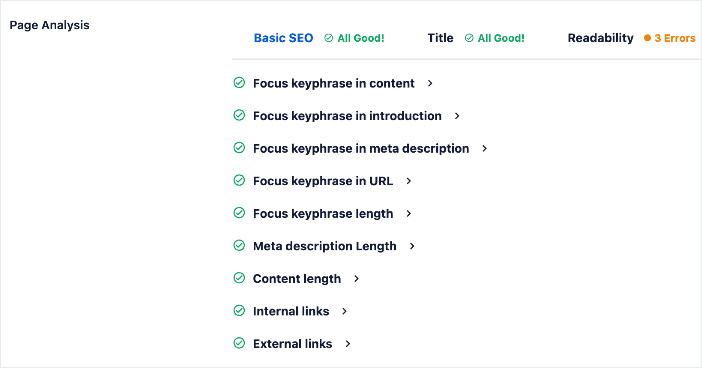

The TruSEO On-page Analysis gives you a score of how well-optimized your content is. It even gives you recommendations for improving your it. Besides the TruSEO On-page Analysis, you can also use AIOSEO’s TruSEO Highlighter to optimize your content on the go.


The TruSEO Highlighter analyzes your page content and makes readability recommendations. It also highlights items that need fixing.
This shows you various elements of your content including:
- Subheading distribution
- Passive voice
- Transition words
The feature also gives you recommendations for fixing any on-page SEO errors it finds.
Other tips for creating SEO-friendly content include:
Optimized content is one of the best ways to rank a new website, as it makes it easier for readers to share your content, resulting in a boost in relevant traffic. It also makes it easier to build relevant backlinks to your content. These signal to search engines that your content is valuable, leading to better search rankings.
Check out this case study on how a golfing blog grew its traffic by 190% YOY by optimizing its content.
5. Create Topic Clusters
Topic clusters are a group of relevant content pieces that comprehensively cover a subject from many angles and are interlinked. They help build topical authority and enhance your semantic SEO, both great ways of getting your site and content to rank in a competitive niche.
Creating a topic cluster requires 2 main components:
Cornerstone Content (Pillar Page)
Your cornerstone content is the hub of the topic cluster. This page covers the main subject in-depth, with each subheading briefly addressing related subtopics.
You can easily mark these using AIOSEO’s Cornerstone Content feature:
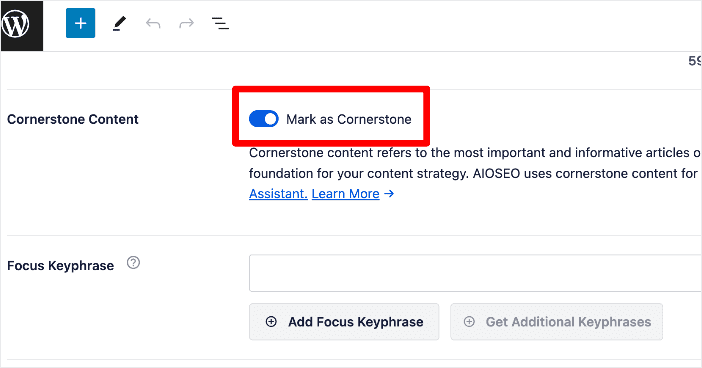

Marking your post/page as cornerstone content also adds it to a new post list filter dedicated to cornerstone content.


This filter allows you to see your important pages at a glance, making it easier to create links to them.
Subtopic Pages
Subtopic pages are the pieces of content you create to provide in-depth coverage of a single aspect of the main subject and link to the pillar page.
Once you’ve built your pillar pages and subtopics, create strategic internal links between them. You can automate this by using AIOSEO’s Link Assistant module, where a building icon denotes the cornerstone content.
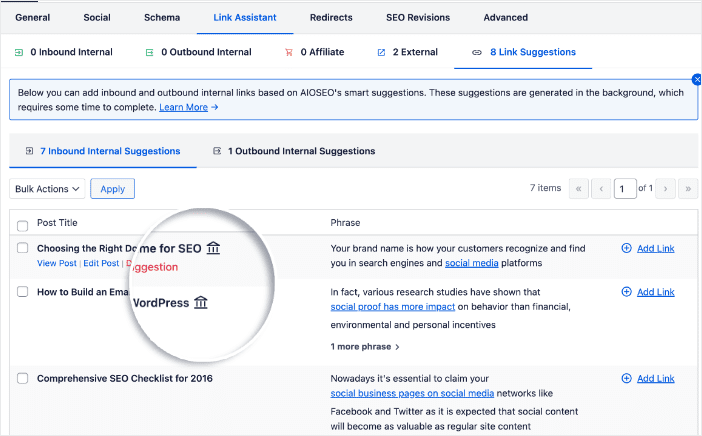

Click the Add Link button to add links to your cornerstone content, and Link Assistant will work its magic in the background. You don’t even have to open the pages in editor mode!
Creating topic clusters has never been as easy as it is with AIOSEO’s Cornerstone Content.
6. Aim for the Featured Snippet
Another SEO growth hack to employ is aiming for the featured image. A featured snippet is a special type of search result displayed at the top of Google’s search engine results page (SERP) that aims to provide users with a direct and concise answer to their query.
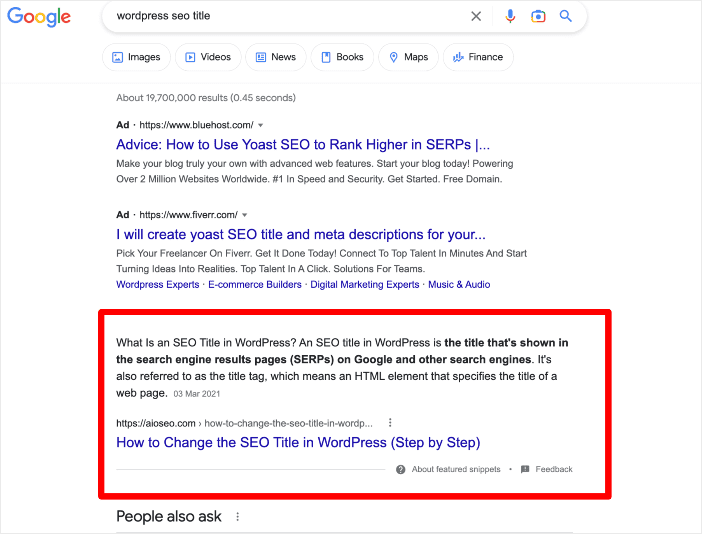

A few ways to land the featured snippet include:
- Implementing schema markup
- Using a table of contents
- Adding FAQs to your content
- Optimizing your content
- Creating the best piece of content on the topic
Featured snippets are often called “position zero” because they appear above the standard organic search results.
For tips on optimizing for this coveted piece of real estate on SERPs, check out our tutorial on getting the featured snippet. You can also check out how a food blog grew its traffic from 77K to 1 million in just 2 months. Part of their strategy was optimizing for the featured snippets.
7. Target Google’s People Also Ask (PAA) Section
Google’s People Also Ask (PAA) refers to related questions searchers may have about your particular topic.
The PAA section of Google’s SERPs is a prominent feature that gives publishers an opportunity to bolster their visibility on search engines further.
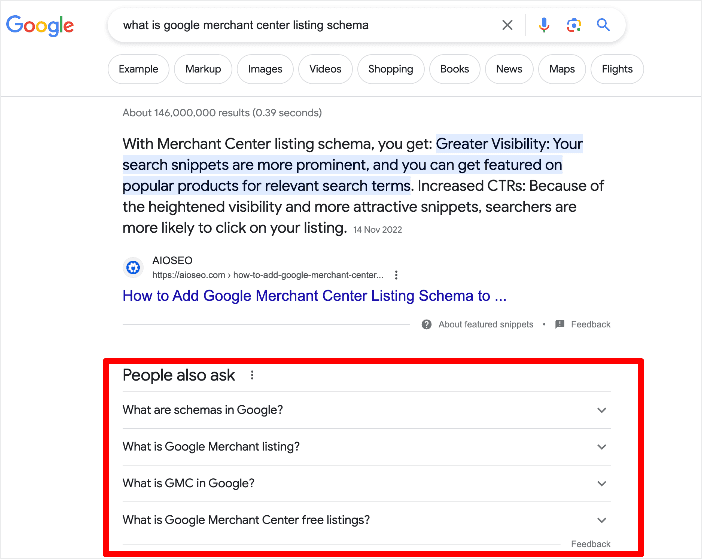

Optimizing for the PAA section also helps you bolster your semantic SEO strategy. This is because answering the common questions users ask in relation to your primary keyword helps you create content with semantic depth. It also helps you capture traffic for long-tail keywords.
You can check out our guide to optimizing for Google’s people also ask section for step-by-step instructions. Here’s a case study of how a food blog optimized its content for the PAA section and grew traffic by 508% in 3 months.
8. Build Strategic Links
Another popular SEO growth hack is link building. However, for it to be impactful, you must do it right. The 3 types of links you should focus on are:
Internal links
These are links between pages on your website. They have many SEO benefits, including distributing link juice across your pages, improving crawling and indexing, enhancing user experience, and more.
Building strategic internal links is a breeze with AIOSEO’s Link Assistant. You don’t have to manually add them.
Link Assistant is an AI-powered tool that crawls your site and gives a report of all the links on your site.
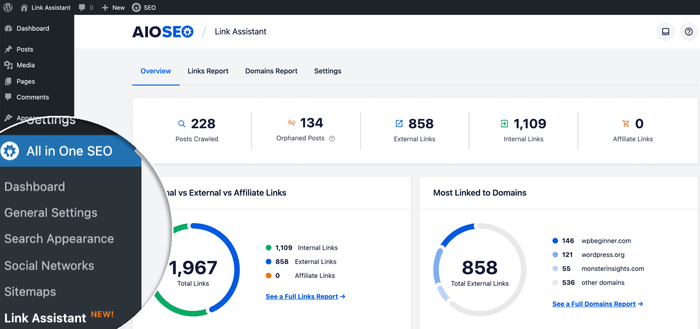

It also gives you a Links Report that shows you internal linking suggestions and the orphan pages on your site.


The report also shows you all the internal links to and from a post, affiliate links on a post, and all external links. Most importantly, it gives you internal linking suggestions.
The best part is that you don’t even need to open a post to add the links. You can just do so from the Link Assistant dashboard.
Backlinks
Backlinks are links from external sites to your site. They are important because they serve as a vote of confidence that your site is reliable and the content valuable. A few ways of building backlinks include:
- Guest posting
- Listing on business directories
- Running outreach campaigns
Check out our link building guide for tips on building backlinks and external links. You can also check out this case study of how Explore.com quadrupled its traffic in 10 months. One of their growth tactics was obtaining high-quality backlinks.
9. Find and Fix Broken Links
Broken links are bad for SEO as they result in crawl errors and a negative user experience. This can result in poor SEO performance and higher bounce rates.
That’s why you should regularly monitor your site for broken links and fix them. This can be easily done with AIOSEO’s Broken Link Checker, a tool that crawls your site to find broken links.


This powerful tool does more than find broken links. It also offers you solutions for fixing them.
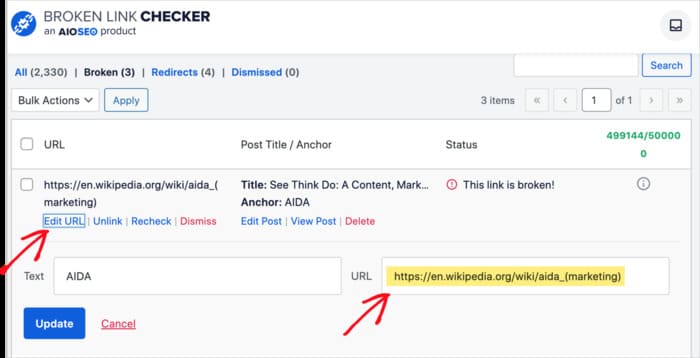

Because Broken Link Checker automatically checks your site for broken links, you reduce the occurrence of crawl errors.
Check out our guide on finding and fixing broken links for detailed instructions on eliminating broken links on your site.
10. Watch Out For Content Decay
Content decay is the gradual decrease in organic performance for content designed specifically for SEO. It’s called content decay because the decline in performance is gradual rather than a sharp drop-off.
Content decay is a silent killer of your SEO efforts and should be curbed as soon as possible.
Thankfully, spotting content decay is super easy with AIOSEO’s Search Statistics feature, which shows you Google Search Console (GSC) data right inside your WordPress dashboard. And one of the insights it gives is a Content Performance report.
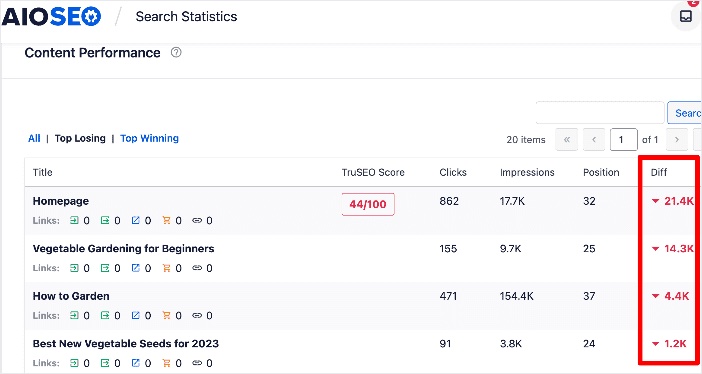

From the Content Performance report, you can see the Top Losing content. The Diff tab shows a proprietary point system that shows the rate at which your content is decaying.
For more information, check out our tutorial on spotting and combatting content decay.
11. Use AI to Create Your Meta Data
Metadata, like your SEO title tags and meta descriptions, are important elements of SEO. This is because they’re the first elements of your content that users interact with on SERPs. A few tips for optimizing your SEO title tags and meta descriptions include:
- Your keyword
- The name of the product/service
- A user-focused, search intent-driven description
Having all this information in your SEO title tags and meta descriptions will help users know if your content is what they’re looking for. It will also help your pages rank well on search engines.
Fortunately, you can use AI for this mundane task. You can automatically generate SEO titles and meta descriptions using AIOSEO’s AI Title/Description Generator.
The AI-powered tool generates SEO title tags and meta descriptions from your content and gives you 5 suggestions.
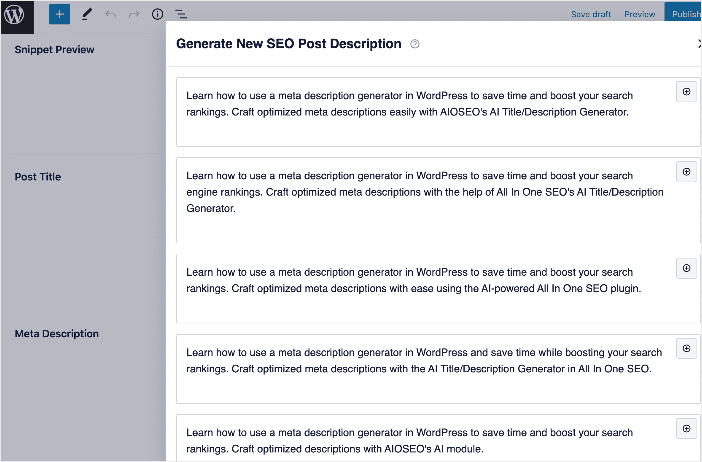

And it does all this at the single click of a button. The best part is the meta data is SEO-friendly!
For detailed instructions on using this powerful feature, check out our guide on generating meta descriptions using AI.
12. Optimize for Local SEO (Optional)
If you’re a local business that relies on foot traffic, then one of the most important SEO growth hacks for you is optimizing for local SEO.
Local SEO refers to the strategies a business uses to improve its online visibility to reach a location-specific audience. For instance, if you run a brick-and-mortar store or offer local services like plumbing, you can use your website to reach a local audience. A few tips for getting your local SEO right include:
- Getting your local on-page SEO right
- Listing on business directories
- Building and optimizing local citations
You can also use AIOSEO’s Local Business SEO module to increase your visibility for local searches and on Google Maps. This is a great way to rank high for local searches, including voice searches.
Need detailed steps for boosting your local SEO?
Then check out our local SEO checklist.
13. Pay Attention to Site Security
Website security is one of the SEO growth hacks that don’t get the attention they deserve. Security is a key ranking factor as search engines want to ensure the websites they recommend are secure and protect users’ privacy.
And that’s why implementing SSL/HTTPS on your site is strongly recommended. Once you install an SSL certificate on your site, a padlock sign will appear in the address bar. This shows your visitors that they’re on a secure page.
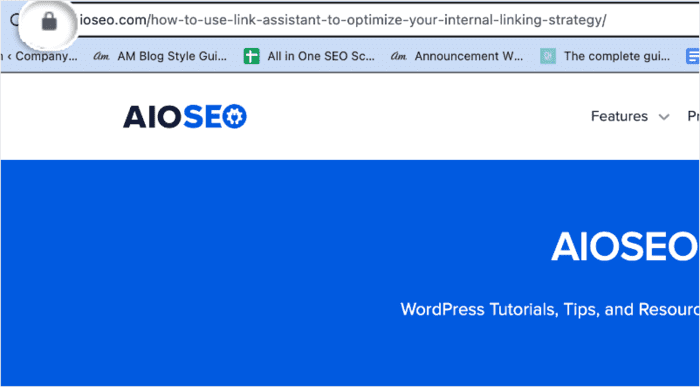

In addition, your website address will begin with HTTPS instead of just HTTP. These visual queues are a great way to gain user trust, an important factor in encouraging repeat visitors.
Check out our article on HTTPS and SEO for more details on the impact site security has on your search rankings.
14. Measure, Analyse, and Refine
One mistake many marketers and small business owners make with SEO is neglecting to measure results. Monitoring your SEO performance is one of the SEO growth hacks you should prioritize.
You need to monitor and measure your performance based on the goals and KPIs you’ve set for your SEO campaigns.
There are many SEO monitoring tools you can use for this. However, if you’re a WordPress user, AIOSEO’s Search Statistics makes everything easier. For example, you can use AIOSEO’s Search Statistics to monitor your important metrics like clicks, average CTR, search impressions, search position and more.
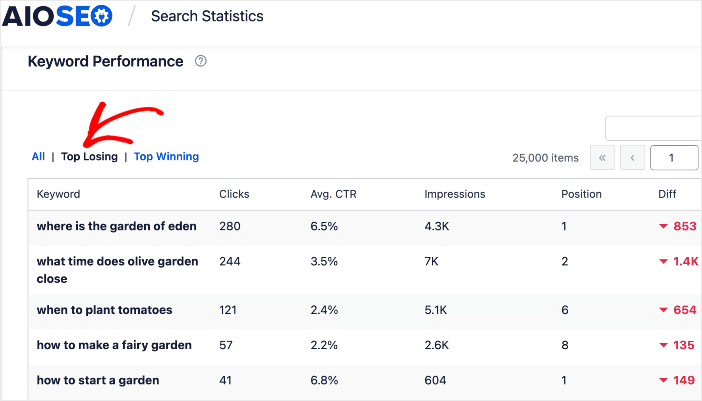

Measuring your SEO performance in WordPress couldn’t be easier.
If the data in the reports shows that you’re not quite hitting your SEO goals, you can use it to figure out how to adjust your campaigns so they perform better.
SEO Growth Hacks: Your FAQs Answered
What are SEO Growth Hacks?
SEO growth hacks are strategic and innovative techniques to enhance a website’s search engine ranking and outperform competitors. These tactics go beyond conventional SEO methods, aiming to provide a competitive edge in the dynamic digital landscape.
How Can I Make My SEO Successful?
SEO success requires a multifaceted approach. Start by conducting thorough keyword research, optimizing your content for relevance and quality, and building a strong link profile. You should also stay current on industry trends. Additionally, implementing SEO growth hacks, as this guide outlines, can propel your SEO success further.
How Can I Measure SEO Success?
To measure SEO success, track key metrics such as organic traffic, keyword rankings, conversion rates, and user engagement. For WordPress users, AIOSEO’s Search Statistics can give you all this data right in your WordPress dashboard.
SEO Growth Hacks: Boost Your Rankings and Drive Relevant Traffic
We hope this post has helped you discover some impactful SEO growth hacks to help boost your rankings and drive relevant traffic. You may also want to check out other articles on our blog, like our beginners’ guide to SEO or our ultimate WordPress SEO checklist.
If you found this article helpful, then please subscribe to our YouTube Channel. You’ll find many more helpful tutorials there. You can also follow us on X (Twitter), LinkedIn, or Facebook to stay in the loop.



